Procter & Gamble: Analysis of Organization, Leadership, and Management
VerifiedAdded on 2021/10/06
|12
|6166
|61
Report
AI Summary
This report provides an analysis of Procter & Gamble (P&G), examining its organizational structure, management strategies, and leadership approaches. It discusses P&G's history, its commitment to innovation, and its global presence with numerous branches and development centers. The report highlights P&G's environmental sustainability efforts, financial performance, and its multi-brand strategy, which allows it to compete effectively in the market. It also explores P&G's organizational structure, including its evolution and the challenges it faces, such as the need for innovation in subsidiary management. The analysis covers various aspects of P&G's business model, including its commitment to superior quality, differentiated brands, and unique selling propositions, along with the company's efforts to improve children's lives through social responsibility programs. The report uses data from P&G's annual reports and other resources to evaluate the company's performance, forecast its future development, and assess its management and leadership.
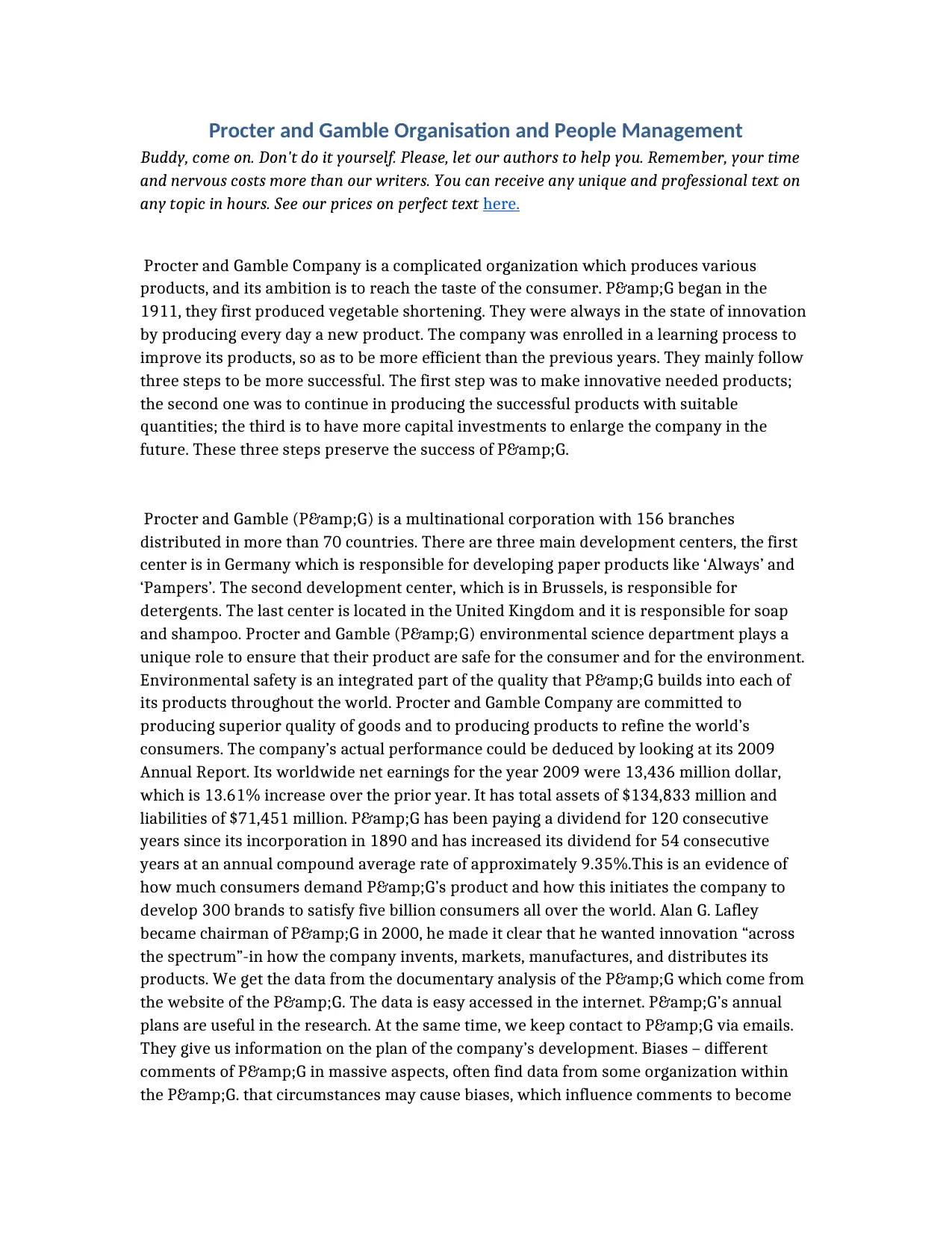
Procter and Gamble Organisation and People Management
Buddy, come on. Don't do it yourself. Please, let our authors to help you. Remember, your time
and nervous costs more than our writers. You can receive any unique and professional text on
any topic in hours. See our prices on perfect text here.
Procter and Gamble Company is a complicated organization which produces various
products, and its ambition is to reach the taste of the consumer. P&G began in the
1911, they first produced vegetable shortening. They were always in the state of innovation
by producing every day a new product. The company was enrolled in a learning process to
improve its products, so as to be more efficient than the previous years. They mainly follow
three steps to be more successful. The first step was to make innovative needed products;
the second one was to continue in producing the successful products with suitable
quantities; the third is to have more capital investments to enlarge the company in the
future. These three steps preserve the success of P&G.
Procter and Gamble (P&G) is a multinational corporation with 156 branches
distributed in more than 70 countries. There are three main development centers, the first
center is in Germany which is responsible for developing paper products like ‘Always’ and
‘Pampers’. The second development center, which is in Brussels, is responsible for
detergents. The last center is located in the United Kingdom and it is responsible for soap
and shampoo. Procter and Gamble (P&G) environmental science department plays a
unique role to ensure that their product are safe for the consumer and for the environment.
Environmental safety is an integrated part of the quality that P&G builds into each of
its products throughout the world. Procter and Gamble Company are committed to
producing superior quality of goods and to producing products to refine the world’s
consumers. The company’s actual performance could be deduced by looking at its 2009
Annual Report. Its worldwide net earnings for the year 2009 were 13,436 million dollar,
which is 13.61% increase over the prior year. It has total assets of $134,833 million and
liabilities of $71,451 million. P&G has been paying a dividend for 120 consecutive
years since its incorporation in 1890 and has increased its dividend for 54 consecutive
years at an annual compound average rate of approximately 9.35%.This is an evidence of
how much consumers demand P&G’s product and how this initiates the company to
develop 300 brands to satisfy five billion consumers all over the world. Alan G. Lafley
became chairman of P&G in 2000, he made it clear that he wanted innovation “across
the spectrum”-in how the company invents, markets, manufactures, and distributes its
products. We get the data from the documentary analysis of the P&G which come from
the website of the P&G. The data is easy accessed in the internet. P&G’s annual
plans are useful in the research. At the same time, we keep contact to P&G via emails.
They give us information on the plan of the company’s development. Biases – different
comments of P&G in massive aspects, often find data from some organization within
the P&G. that circumstances may cause biases, which influence comments to become
Buddy, come on. Don't do it yourself. Please, let our authors to help you. Remember, your time
and nervous costs more than our writers. You can receive any unique and professional text on
any topic in hours. See our prices on perfect text here.
Procter and Gamble Company is a complicated organization which produces various
products, and its ambition is to reach the taste of the consumer. P&G began in the
1911, they first produced vegetable shortening. They were always in the state of innovation
by producing every day a new product. The company was enrolled in a learning process to
improve its products, so as to be more efficient than the previous years. They mainly follow
three steps to be more successful. The first step was to make innovative needed products;
the second one was to continue in producing the successful products with suitable
quantities; the third is to have more capital investments to enlarge the company in the
future. These three steps preserve the success of P&G.
Procter and Gamble (P&G) is a multinational corporation with 156 branches
distributed in more than 70 countries. There are three main development centers, the first
center is in Germany which is responsible for developing paper products like ‘Always’ and
‘Pampers’. The second development center, which is in Brussels, is responsible for
detergents. The last center is located in the United Kingdom and it is responsible for soap
and shampoo. Procter and Gamble (P&G) environmental science department plays a
unique role to ensure that their product are safe for the consumer and for the environment.
Environmental safety is an integrated part of the quality that P&G builds into each of
its products throughout the world. Procter and Gamble Company are committed to
producing superior quality of goods and to producing products to refine the world’s
consumers. The company’s actual performance could be deduced by looking at its 2009
Annual Report. Its worldwide net earnings for the year 2009 were 13,436 million dollar,
which is 13.61% increase over the prior year. It has total assets of $134,833 million and
liabilities of $71,451 million. P&G has been paying a dividend for 120 consecutive
years since its incorporation in 1890 and has increased its dividend for 54 consecutive
years at an annual compound average rate of approximately 9.35%.This is an evidence of
how much consumers demand P&G’s product and how this initiates the company to
develop 300 brands to satisfy five billion consumers all over the world. Alan G. Lafley
became chairman of P&G in 2000, he made it clear that he wanted innovation “across
the spectrum”-in how the company invents, markets, manufactures, and distributes its
products. We get the data from the documentary analysis of the P&G which come from
the website of the P&G. The data is easy accessed in the internet. P&G’s annual
plans are useful in the research. At the same time, we keep contact to P&G via emails.
They give us information on the plan of the company’s development. Biases – different
comments of P&G in massive aspects, often find data from some organization within
the P&G. that circumstances may cause biases, which influence comments to become
Paraphrase This Document
Need a fresh take? Get an instant paraphrase of this document with our AI Paraphraser
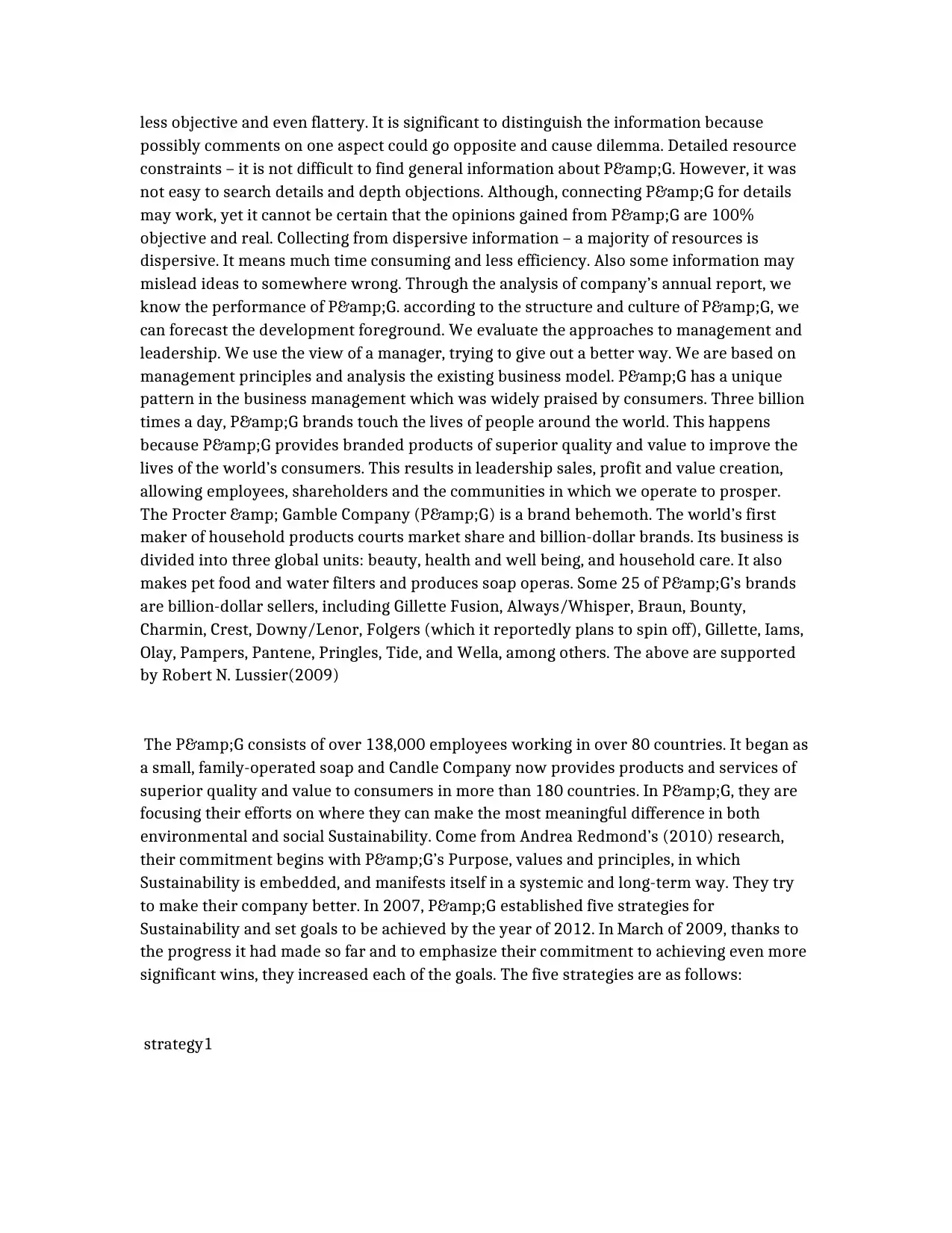
less objective and even flattery. It is significant to distinguish the information because
possibly comments on one aspect could go opposite and cause dilemma. Detailed resource
constraints – it is not difficult to find general information about P&G. However, it was
not easy to search details and depth objections. Although, connecting P&G for details
may work, yet it cannot be certain that the opinions gained from P&G are 100%
objective and real. Collecting from dispersive information – a majority of resources is
dispersive. It means much time consuming and less efficiency. Also some information may
mislead ideas to somewhere wrong. Through the analysis of company’s annual report, we
know the performance of P&G. according to the structure and culture of P&G, we
can forecast the development foreground. We evaluate the approaches to management and
leadership. We use the view of a manager, trying to give out a better way. We are based on
management principles and analysis the existing business model. P&G has a unique
pattern in the business management which was widely praised by consumers. Three billion
times a day, P&G brands touch the lives of people around the world. This happens
because P&G provides branded products of superior quality and value to improve the
lives of the world’s consumers. This results in leadership sales, profit and value creation,
allowing employees, shareholders and the communities in which we operate to prosper.
The Procter & Gamble Company (P&G) is a brand behemoth. The world’s first
maker of household products courts market share and billion-dollar brands. Its business is
divided into three global units: beauty, health and well being, and household care. It also
makes pet food and water filters and produces soap operas. Some 25 of P&G’s brands
are billion-dollar sellers, including Gillette Fusion, Always/Whisper, Braun, Bounty,
Charmin, Crest, Downy/Lenor, Folgers (which it reportedly plans to spin off), Gillette, Iams,
Olay, Pampers, Pantene, Pringles, Tide, and Wella, among others. The above are supported
by Robert N. Lussier(2009)
The P&G consists of over 138,000 employees working in over 80 countries. It began as
a small, family-operated soap and Candle Company now provides products and services of
superior quality and value to consumers in more than 180 countries. In P&G, they are
focusing their efforts on where they can make the most meaningful difference in both
environmental and social Sustainability. Come from Andrea Redmond’s (2010) research,
their commitment begins with P&G’s Purpose, values and principles, in which
Sustainability is embedded, and manifests itself in a systemic and long-term way. They try
to make their company better. In 2007, P&G established five strategies for
Sustainability and set goals to be achieved by the year of 2012. In March of 2009, thanks to
the progress it had made so far and to emphasize their commitment to achieving even more
significant wins, they increased each of the goals. The five strategies are as follows:
strategy1
possibly comments on one aspect could go opposite and cause dilemma. Detailed resource
constraints – it is not difficult to find general information about P&G. However, it was
not easy to search details and depth objections. Although, connecting P&G for details
may work, yet it cannot be certain that the opinions gained from P&G are 100%
objective and real. Collecting from dispersive information – a majority of resources is
dispersive. It means much time consuming and less efficiency. Also some information may
mislead ideas to somewhere wrong. Through the analysis of company’s annual report, we
know the performance of P&G. according to the structure and culture of P&G, we
can forecast the development foreground. We evaluate the approaches to management and
leadership. We use the view of a manager, trying to give out a better way. We are based on
management principles and analysis the existing business model. P&G has a unique
pattern in the business management which was widely praised by consumers. Three billion
times a day, P&G brands touch the lives of people around the world. This happens
because P&G provides branded products of superior quality and value to improve the
lives of the world’s consumers. This results in leadership sales, profit and value creation,
allowing employees, shareholders and the communities in which we operate to prosper.
The Procter & Gamble Company (P&G) is a brand behemoth. The world’s first
maker of household products courts market share and billion-dollar brands. Its business is
divided into three global units: beauty, health and well being, and household care. It also
makes pet food and water filters and produces soap operas. Some 25 of P&G’s brands
are billion-dollar sellers, including Gillette Fusion, Always/Whisper, Braun, Bounty,
Charmin, Crest, Downy/Lenor, Folgers (which it reportedly plans to spin off), Gillette, Iams,
Olay, Pampers, Pantene, Pringles, Tide, and Wella, among others. The above are supported
by Robert N. Lussier(2009)
The P&G consists of over 138,000 employees working in over 80 countries. It began as
a small, family-operated soap and Candle Company now provides products and services of
superior quality and value to consumers in more than 180 countries. In P&G, they are
focusing their efforts on where they can make the most meaningful difference in both
environmental and social Sustainability. Come from Andrea Redmond’s (2010) research,
their commitment begins with P&G’s Purpose, values and principles, in which
Sustainability is embedded, and manifests itself in a systemic and long-term way. They try
to make their company better. In 2007, P&G established five strategies for
Sustainability and set goals to be achieved by the year of 2012. In March of 2009, thanks to
the progress it had made so far and to emphasize their commitment to achieving even more
significant wins, they increased each of the goals. The five strategies are as follows:
strategy1
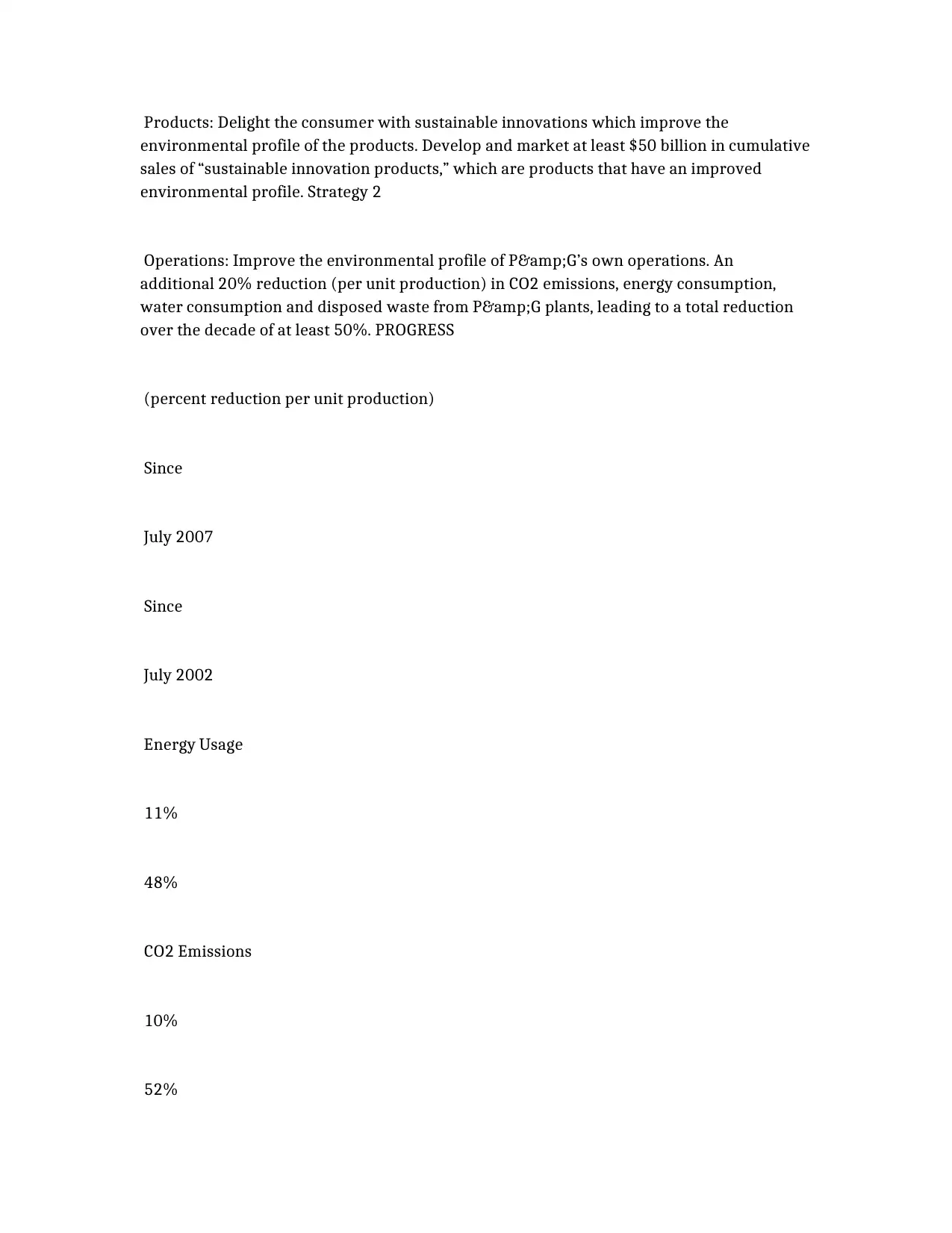
Products: Delight the consumer with sustainable innovations which improve the
environmental profile of the products. Develop and market at least $50 billion in cumulative
sales of “sustainable innovation products,” which are products that have an improved
environmental profile. Strategy 2
Operations: Improve the environmental profile of P&G’s own operations. An
additional 20% reduction (per unit production) in CO2 emissions, energy consumption,
water consumption and disposed waste from P&G plants, leading to a total reduction
over the decade of at least 50%. PROGRESS
(percent reduction per unit production)
Since
July 2007
Since
July 2002
Energy Usage
11%
48%
CO2 Emissions
10%
52%
environmental profile of the products. Develop and market at least $50 billion in cumulative
sales of “sustainable innovation products,” which are products that have an improved
environmental profile. Strategy 2
Operations: Improve the environmental profile of P&G’s own operations. An
additional 20% reduction (per unit production) in CO2 emissions, energy consumption,
water consumption and disposed waste from P&G plants, leading to a total reduction
over the decade of at least 50%. PROGRESS
(percent reduction per unit production)
Since
July 2007
Since
July 2002
Energy Usage
11%
48%
CO2 Emissions
10%
52%
⊘ This is a preview!⊘
Do you want full access?
Subscribe today to unlock all pages.

Trusted by 1+ million students worldwide
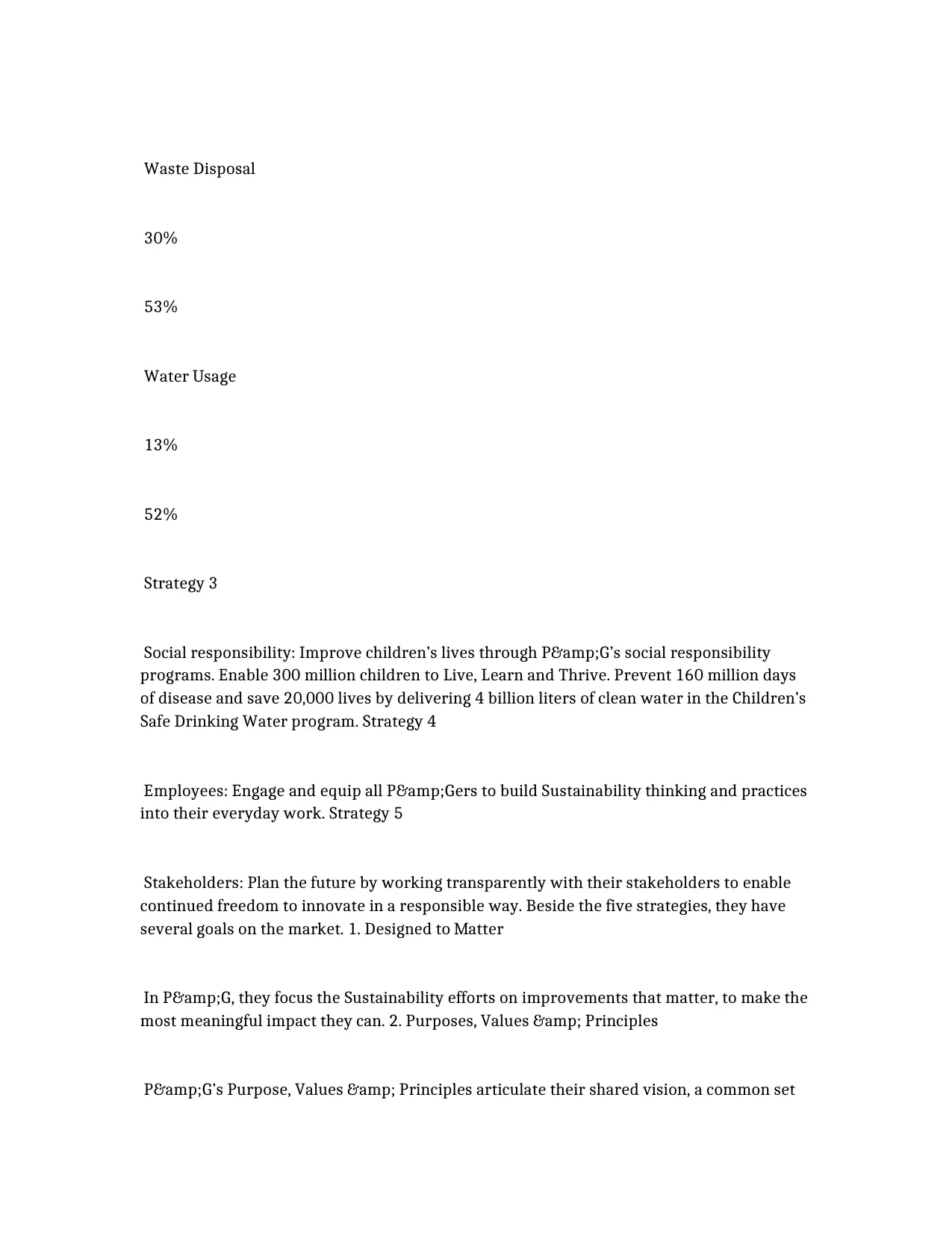
Waste Disposal
30%
53%
Water Usage
13%
52%
Strategy 3
Social responsibility: Improve children’s lives through P&G’s social responsibility
programs. Enable 300 million children to Live, Learn and Thrive. Prevent 160 million days
of disease and save 20,000 lives by delivering 4 billion liters of clean water in the Children’s
Safe Drinking Water program. Strategy 4
Employees: Engage and equip all P&Gers to build Sustainability thinking and practices
into their everyday work. Strategy 5
Stakeholders: Plan the future by working transparently with their stakeholders to enable
continued freedom to innovate in a responsible way. Beside the five strategies, they have
several goals on the market. 1. Designed to Matter
In P&G, they focus the Sustainability efforts on improvements that matter, to make the
most meaningful impact they can. 2. Purposes, Values & Principles
P&G’s Purpose, Values & Principles articulate their shared vision, a common set
30%
53%
Water Usage
13%
52%
Strategy 3
Social responsibility: Improve children’s lives through P&G’s social responsibility
programs. Enable 300 million children to Live, Learn and Thrive. Prevent 160 million days
of disease and save 20,000 lives by delivering 4 billion liters of clean water in the Children’s
Safe Drinking Water program. Strategy 4
Employees: Engage and equip all P&Gers to build Sustainability thinking and practices
into their everyday work. Strategy 5
Stakeholders: Plan the future by working transparently with their stakeholders to enable
continued freedom to innovate in a responsible way. Beside the five strategies, they have
several goals on the market. 1. Designed to Matter
In P&G, they focus the Sustainability efforts on improvements that matter, to make the
most meaningful impact they can. 2. Purposes, Values & Principles
P&G’s Purpose, Values & Principles articulate their shared vision, a common set
Paraphrase This Document
Need a fresh take? Get an instant paraphrase of this document with our AI Paraphraser
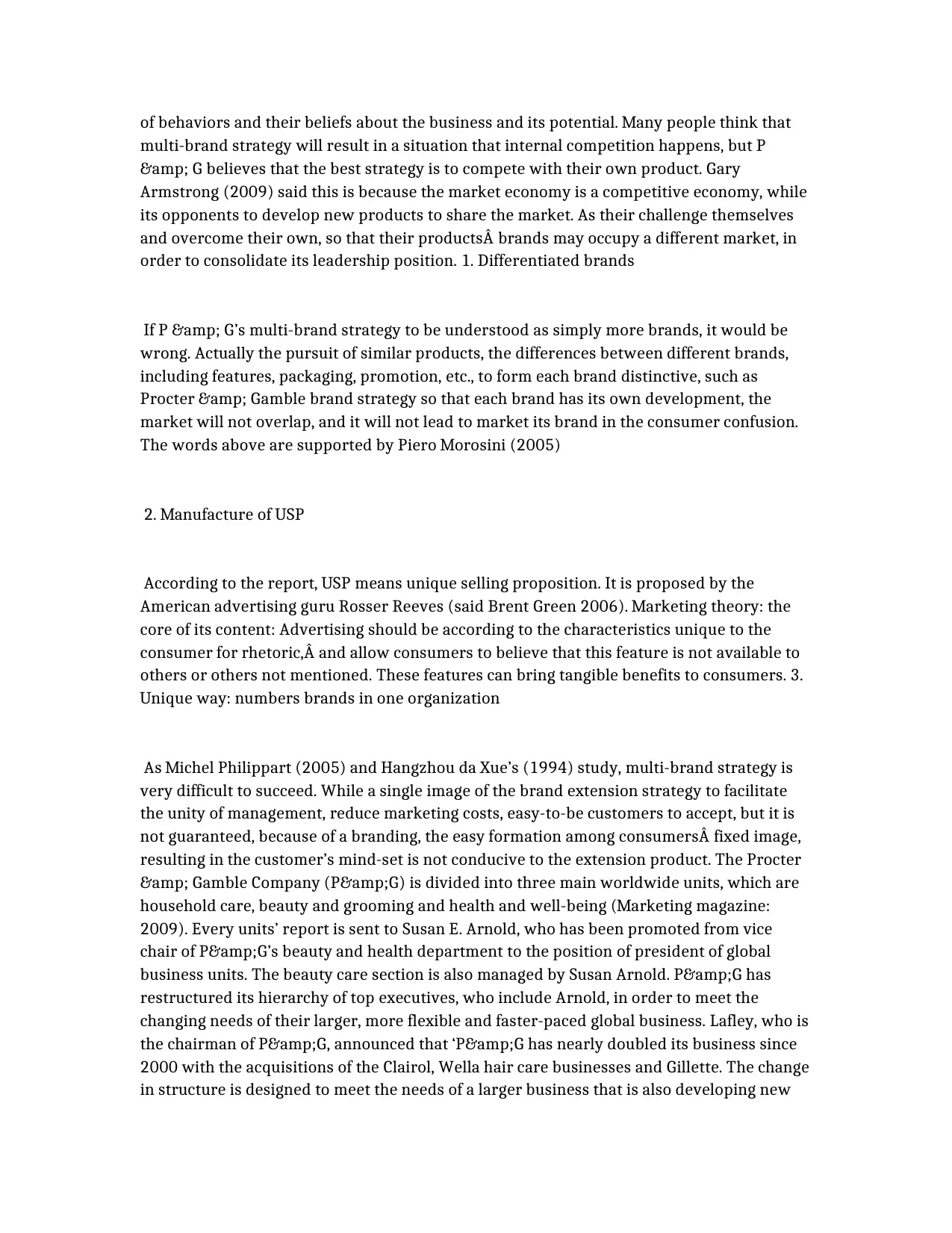
of behaviors and their beliefs about the business and its potential. Many people think that
multi-brand strategy will result in a situation that internal competition happens, but P
& G believes that the best strategy is to compete with their own product. Gary
Armstrong (2009) said this is because the market economy is a competitive economy, while
its opponents to develop new products to share the market. As their challenge themselves
and overcome their own, so that their products brands may occupy a different market, in
order to consolidate its leadership position. 1. Differentiated brands
If P & G’s multi-brand strategy to be understood as simply more brands, it would be
wrong. Actually the pursuit of similar products, the differences between different brands,
including features, packaging, promotion, etc., to form each brand distinctive, such as
Procter & Gamble brand strategy so that each brand has its own development, the
market will not overlap, and it will not lead to market its brand in the consumer confusion.
The words above are supported by Piero Morosini (2005)
2. Manufacture of USP
According to the report, USP means unique selling proposition. It is proposed by the
American advertising guru Rosser Reeves (said Brent Green 2006). Marketing theory: the
core of its content: Advertising should be according to the characteristics unique to the
consumer for rhetoric, and allow consumers to believe that this feature is not available to
others or others not mentioned. These features can bring tangible benefits to consumers. 3.
Unique way: numbers brands in one organization
As Michel Philippart (2005) and Hangzhou da Xue’s (1994) study, multi-brand strategy is
very difficult to succeed. While a single image of the brand extension strategy to facilitate
the unity of management, reduce marketing costs, easy-to-be customers to accept, but it is
not guaranteed, because of a branding, the easy formation among consumers fixed image,
resulting in the customer’s mind-set is not conducive to the extension product. The Procter
& Gamble Company (P&G) is divided into three main worldwide units, which are
household care, beauty and grooming and health and well-being (Marketing magazine:
2009). Every units’ report is sent to Susan E. Arnold, who has been promoted from vice
chair of P&G’s beauty and health department to the position of president of global
business units. The beauty care section is also managed by Susan Arnold. P&G has
restructured its hierarchy of top executives, who include Arnold, in order to meet the
changing needs of their larger, more flexible and faster-paced global business. Lafley, who is
the chairman of P&G, announced that ‘P&G has nearly doubled its business since
2000 with the acquisitions of the Clairol, Wella hair care businesses and Gillette. The change
in structure is designed to meet the needs of a larger business that is also developing new
multi-brand strategy will result in a situation that internal competition happens, but P
& G believes that the best strategy is to compete with their own product. Gary
Armstrong (2009) said this is because the market economy is a competitive economy, while
its opponents to develop new products to share the market. As their challenge themselves
and overcome their own, so that their products brands may occupy a different market, in
order to consolidate its leadership position. 1. Differentiated brands
If P & G’s multi-brand strategy to be understood as simply more brands, it would be
wrong. Actually the pursuit of similar products, the differences between different brands,
including features, packaging, promotion, etc., to form each brand distinctive, such as
Procter & Gamble brand strategy so that each brand has its own development, the
market will not overlap, and it will not lead to market its brand in the consumer confusion.
The words above are supported by Piero Morosini (2005)
2. Manufacture of USP
According to the report, USP means unique selling proposition. It is proposed by the
American advertising guru Rosser Reeves (said Brent Green 2006). Marketing theory: the
core of its content: Advertising should be according to the characteristics unique to the
consumer for rhetoric, and allow consumers to believe that this feature is not available to
others or others not mentioned. These features can bring tangible benefits to consumers. 3.
Unique way: numbers brands in one organization
As Michel Philippart (2005) and Hangzhou da Xue’s (1994) study, multi-brand strategy is
very difficult to succeed. While a single image of the brand extension strategy to facilitate
the unity of management, reduce marketing costs, easy-to-be customers to accept, but it is
not guaranteed, because of a branding, the easy formation among consumers fixed image,
resulting in the customer’s mind-set is not conducive to the extension product. The Procter
& Gamble Company (P&G) is divided into three main worldwide units, which are
household care, beauty and grooming and health and well-being (Marketing magazine:
2009). Every units’ report is sent to Susan E. Arnold, who has been promoted from vice
chair of P&G’s beauty and health department to the position of president of global
business units. The beauty care section is also managed by Susan Arnold. P&G has
restructured its hierarchy of top executives, who include Arnold, in order to meet the
changing needs of their larger, more flexible and faster-paced global business. Lafley, who is
the chairman of P&G, announced that ‘P&G has nearly doubled its business since
2000 with the acquisitions of the Clairol, Wella hair care businesses and Gillette. The change
in structure is designed to meet the needs of a larger business that is also developing new
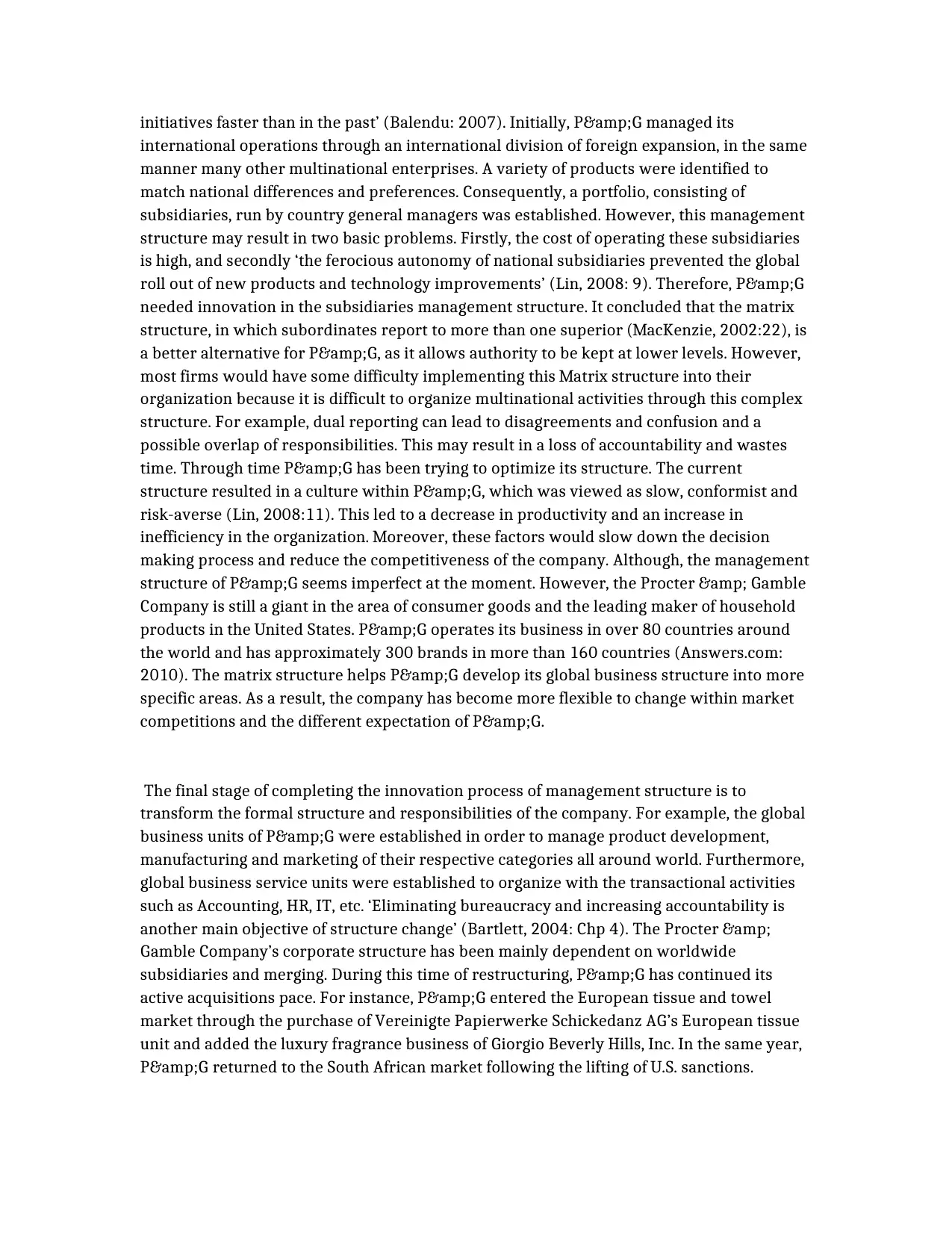
initiatives faster than in the past’ (Balendu: 2007). Initially, P&G managed its
international operations through an international division of foreign expansion, in the same
manner many other multinational enterprises. A variety of products were identified to
match national differences and preferences. Consequently, a portfolio, consisting of
subsidiaries, run by country general managers was established. However, this management
structure may result in two basic problems. Firstly, the cost of operating these subsidiaries
is high, and secondly ‘the ferocious autonomy of national subsidiaries prevented the global
roll out of new products and technology improvements’ (Lin, 2008: 9). Therefore, P&G
needed innovation in the subsidiaries management structure. It concluded that the matrix
structure, in which subordinates report to more than one superior (MacKenzie, 2002:22), is
a better alternative for P&G, as it allows authority to be kept at lower levels. However,
most firms would have some difficulty implementing this Matrix structure into their
organization because it is difficult to organize multinational activities through this complex
structure. For example, dual reporting can lead to disagreements and confusion and a
possible overlap of responsibilities. This may result in a loss of accountability and wastes
time. Through time P&G has been trying to optimize its structure. The current
structure resulted in a culture within P&G, which was viewed as slow, conformist and
risk-averse (Lin, 2008:11). This led to a decrease in productivity and an increase in
inefficiency in the organization. Moreover, these factors would slow down the decision
making process and reduce the competitiveness of the company. Although, the management
structure of P&G seems imperfect at the moment. However, the Procter & Gamble
Company is still a giant in the area of consumer goods and the leading maker of household
products in the United States. P&G operates its business in over 80 countries around
the world and has approximately 300 brands in more than 160 countries (Answers.com:
2010). The matrix structure helps P&G develop its global business structure into more
specific areas. As a result, the company has become more flexible to change within market
competitions and the different expectation of P&G.
The final stage of completing the innovation process of management structure is to
transform the formal structure and responsibilities of the company. For example, the global
business units of P&G were established in order to manage product development,
manufacturing and marketing of their respective categories all around world. Furthermore,
global business service units were established to organize with the transactional activities
such as Accounting, HR, IT, etc. ‘Eliminating bureaucracy and increasing accountability is
another main objective of structure change’ (Bartlett, 2004: Chp 4). The Procter &
Gamble Company’s corporate structure has been mainly dependent on worldwide
subsidiaries and merging. During this time of restructuring, P&G has continued its
active acquisitions pace. For instance, P&G entered the European tissue and towel
market through the purchase of Vereinigte Papierwerke Schickedanz AG’s European tissue
unit and added the luxury fragrance business of Giorgio Beverly Hills, Inc. In the same year,
P&G returned to the South African market following the lifting of U.S. sanctions.
international operations through an international division of foreign expansion, in the same
manner many other multinational enterprises. A variety of products were identified to
match national differences and preferences. Consequently, a portfolio, consisting of
subsidiaries, run by country general managers was established. However, this management
structure may result in two basic problems. Firstly, the cost of operating these subsidiaries
is high, and secondly ‘the ferocious autonomy of national subsidiaries prevented the global
roll out of new products and technology improvements’ (Lin, 2008: 9). Therefore, P&G
needed innovation in the subsidiaries management structure. It concluded that the matrix
structure, in which subordinates report to more than one superior (MacKenzie, 2002:22), is
a better alternative for P&G, as it allows authority to be kept at lower levels. However,
most firms would have some difficulty implementing this Matrix structure into their
organization because it is difficult to organize multinational activities through this complex
structure. For example, dual reporting can lead to disagreements and confusion and a
possible overlap of responsibilities. This may result in a loss of accountability and wastes
time. Through time P&G has been trying to optimize its structure. The current
structure resulted in a culture within P&G, which was viewed as slow, conformist and
risk-averse (Lin, 2008:11). This led to a decrease in productivity and an increase in
inefficiency in the organization. Moreover, these factors would slow down the decision
making process and reduce the competitiveness of the company. Although, the management
structure of P&G seems imperfect at the moment. However, the Procter & Gamble
Company is still a giant in the area of consumer goods and the leading maker of household
products in the United States. P&G operates its business in over 80 countries around
the world and has approximately 300 brands in more than 160 countries (Answers.com:
2010). The matrix structure helps P&G develop its global business structure into more
specific areas. As a result, the company has become more flexible to change within market
competitions and the different expectation of P&G.
The final stage of completing the innovation process of management structure is to
transform the formal structure and responsibilities of the company. For example, the global
business units of P&G were established in order to manage product development,
manufacturing and marketing of their respective categories all around world. Furthermore,
global business service units were established to organize with the transactional activities
such as Accounting, HR, IT, etc. ‘Eliminating bureaucracy and increasing accountability is
another main objective of structure change’ (Bartlett, 2004: Chp 4). The Procter &
Gamble Company’s corporate structure has been mainly dependent on worldwide
subsidiaries and merging. During this time of restructuring, P&G has continued its
active acquisitions pace. For instance, P&G entered the European tissue and towel
market through the purchase of Vereinigte Papierwerke Schickedanz AG’s European tissue
unit and added the luxury fragrance business of Giorgio Beverly Hills, Inc. In the same year,
P&G returned to the South African market following the lifting of U.S. sanctions.
⊘ This is a preview!⊘
Do you want full access?
Subscribe today to unlock all pages.

Trusted by 1+ million students worldwide
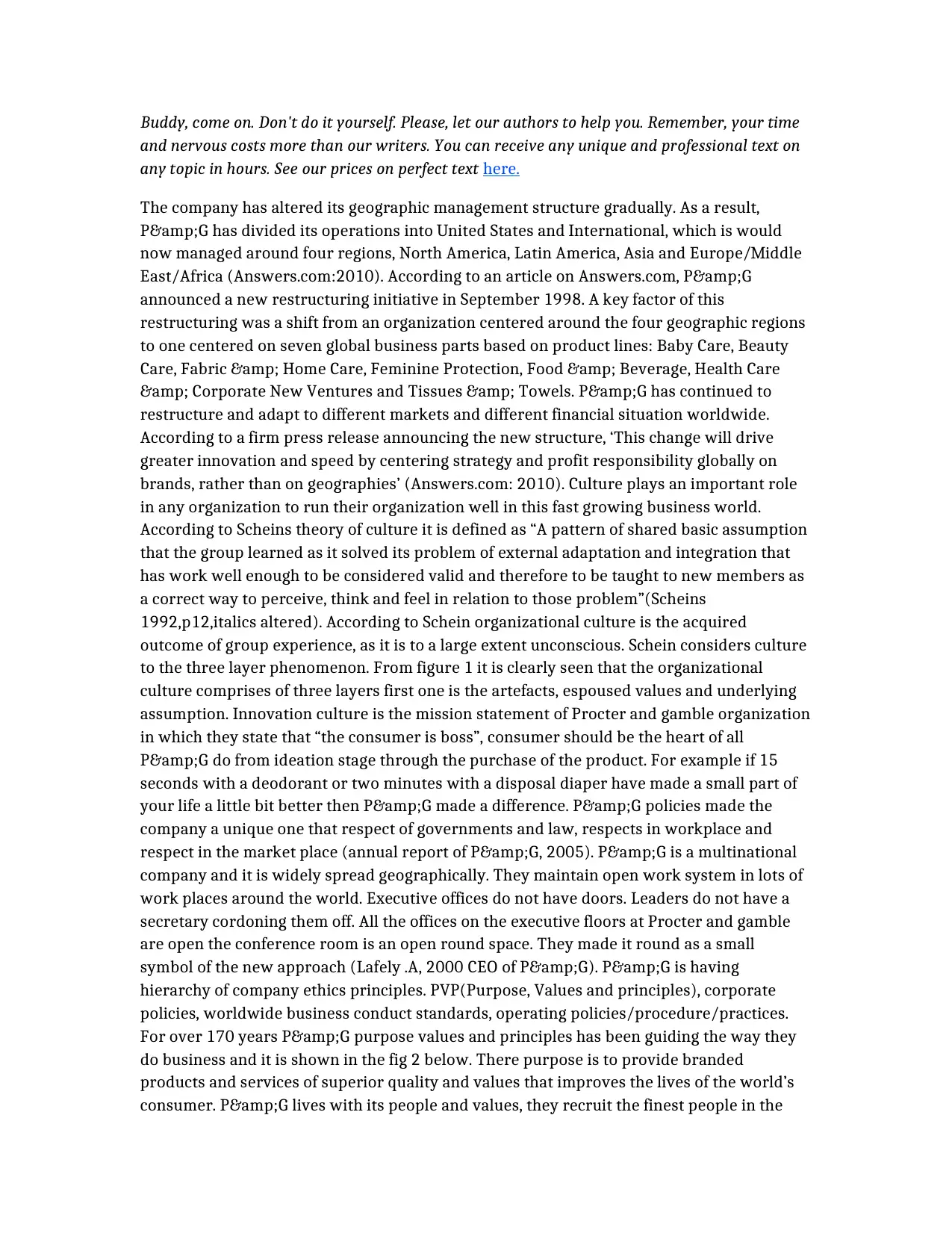
Buddy, come on. Don't do it yourself. Please, let our authors to help you. Remember, your time
and nervous costs more than our writers. You can receive any unique and professional text on
any topic in hours. See our prices on perfect text here.
The company has altered its geographic management structure gradually. As a result,
P&G has divided its operations into United States and International, which is would
now managed around four regions, North America, Latin America, Asia and Europe/Middle
East/Africa (Answers.com:2010). According to an article on Answers.com, P&G
announced a new restructuring initiative in September 1998. A key factor of this
restructuring was a shift from an organization centered around the four geographic regions
to one centered on seven global business parts based on product lines: Baby Care, Beauty
Care, Fabric & Home Care, Feminine Protection, Food & Beverage, Health Care
& Corporate New Ventures and Tissues & Towels. P&G has continued to
restructure and adapt to different markets and different financial situation worldwide.
According to a firm press release announcing the new structure, ‘This change will drive
greater innovation and speed by centering strategy and profit responsibility globally on
brands, rather than on geographies’ (Answers.com: 2010). Culture plays an important role
in any organization to run their organization well in this fast growing business world.
According to Scheins theory of culture it is defined as “A pattern of shared basic assumption
that the group learned as it solved its problem of external adaptation and integration that
has work well enough to be considered valid and therefore to be taught to new members as
a correct way to perceive, think and feel in relation to those problem”(Scheins
1992,p12,italics altered). According to Schein organizational culture is the acquired
outcome of group experience, as it is to a large extent unconscious. Schein considers culture
to the three layer phenomenon. From figure 1 it is clearly seen that the organizational
culture comprises of three layers first one is the artefacts, espoused values and underlying
assumption. Innovation culture is the mission statement of Procter and gamble organization
in which they state that “the consumer is boss”, consumer should be the heart of all
P&G do from ideation stage through the purchase of the product. For example if 15
seconds with a deodorant or two minutes with a disposal diaper have made a small part of
your life a little bit better then P&G made a difference. P&G policies made the
company a unique one that respect of governments and law, respects in workplace and
respect in the market place (annual report of P&G, 2005). P&G is a multinational
company and it is widely spread geographically. They maintain open work system in lots of
work places around the world. Executive offices do not have doors. Leaders do not have a
secretary cordoning them off. All the offices on the executive floors at Procter and gamble
are open the conference room is an open round space. They made it round as a small
symbol of the new approach (Lafely .A, 2000 CEO of P&G). P&G is having
hierarchy of company ethics principles. PVP(Purpose, Values and principles), corporate
policies, worldwide business conduct standards, operating policies/procedure/practices.
For over 170 years P&G purpose values and principles has been guiding the way they
do business and it is shown in the fig 2 below. There purpose is to provide branded
products and services of superior quality and values that improves the lives of the world’s
consumer. P&G lives with its people and values, they recruit the finest people in the
and nervous costs more than our writers. You can receive any unique and professional text on
any topic in hours. See our prices on perfect text here.
The company has altered its geographic management structure gradually. As a result,
P&G has divided its operations into United States and International, which is would
now managed around four regions, North America, Latin America, Asia and Europe/Middle
East/Africa (Answers.com:2010). According to an article on Answers.com, P&G
announced a new restructuring initiative in September 1998. A key factor of this
restructuring was a shift from an organization centered around the four geographic regions
to one centered on seven global business parts based on product lines: Baby Care, Beauty
Care, Fabric & Home Care, Feminine Protection, Food & Beverage, Health Care
& Corporate New Ventures and Tissues & Towels. P&G has continued to
restructure and adapt to different markets and different financial situation worldwide.
According to a firm press release announcing the new structure, ‘This change will drive
greater innovation and speed by centering strategy and profit responsibility globally on
brands, rather than on geographies’ (Answers.com: 2010). Culture plays an important role
in any organization to run their organization well in this fast growing business world.
According to Scheins theory of culture it is defined as “A pattern of shared basic assumption
that the group learned as it solved its problem of external adaptation and integration that
has work well enough to be considered valid and therefore to be taught to new members as
a correct way to perceive, think and feel in relation to those problem”(Scheins
1992,p12,italics altered). According to Schein organizational culture is the acquired
outcome of group experience, as it is to a large extent unconscious. Schein considers culture
to the three layer phenomenon. From figure 1 it is clearly seen that the organizational
culture comprises of three layers first one is the artefacts, espoused values and underlying
assumption. Innovation culture is the mission statement of Procter and gamble organization
in which they state that “the consumer is boss”, consumer should be the heart of all
P&G do from ideation stage through the purchase of the product. For example if 15
seconds with a deodorant or two minutes with a disposal diaper have made a small part of
your life a little bit better then P&G made a difference. P&G policies made the
company a unique one that respect of governments and law, respects in workplace and
respect in the market place (annual report of P&G, 2005). P&G is a multinational
company and it is widely spread geographically. They maintain open work system in lots of
work places around the world. Executive offices do not have doors. Leaders do not have a
secretary cordoning them off. All the offices on the executive floors at Procter and gamble
are open the conference room is an open round space. They made it round as a small
symbol of the new approach (Lafely .A, 2000 CEO of P&G). P&G is having
hierarchy of company ethics principles. PVP(Purpose, Values and principles), corporate
policies, worldwide business conduct standards, operating policies/procedure/practices.
For over 170 years P&G purpose values and principles has been guiding the way they
do business and it is shown in the fig 2 below. There purpose is to provide branded
products and services of superior quality and values that improves the lives of the world’s
consumer. P&G lives with its people and values, they recruit the finest people in the
Paraphrase This Document
Need a fresh take? Get an instant paraphrase of this document with our AI Paraphraser
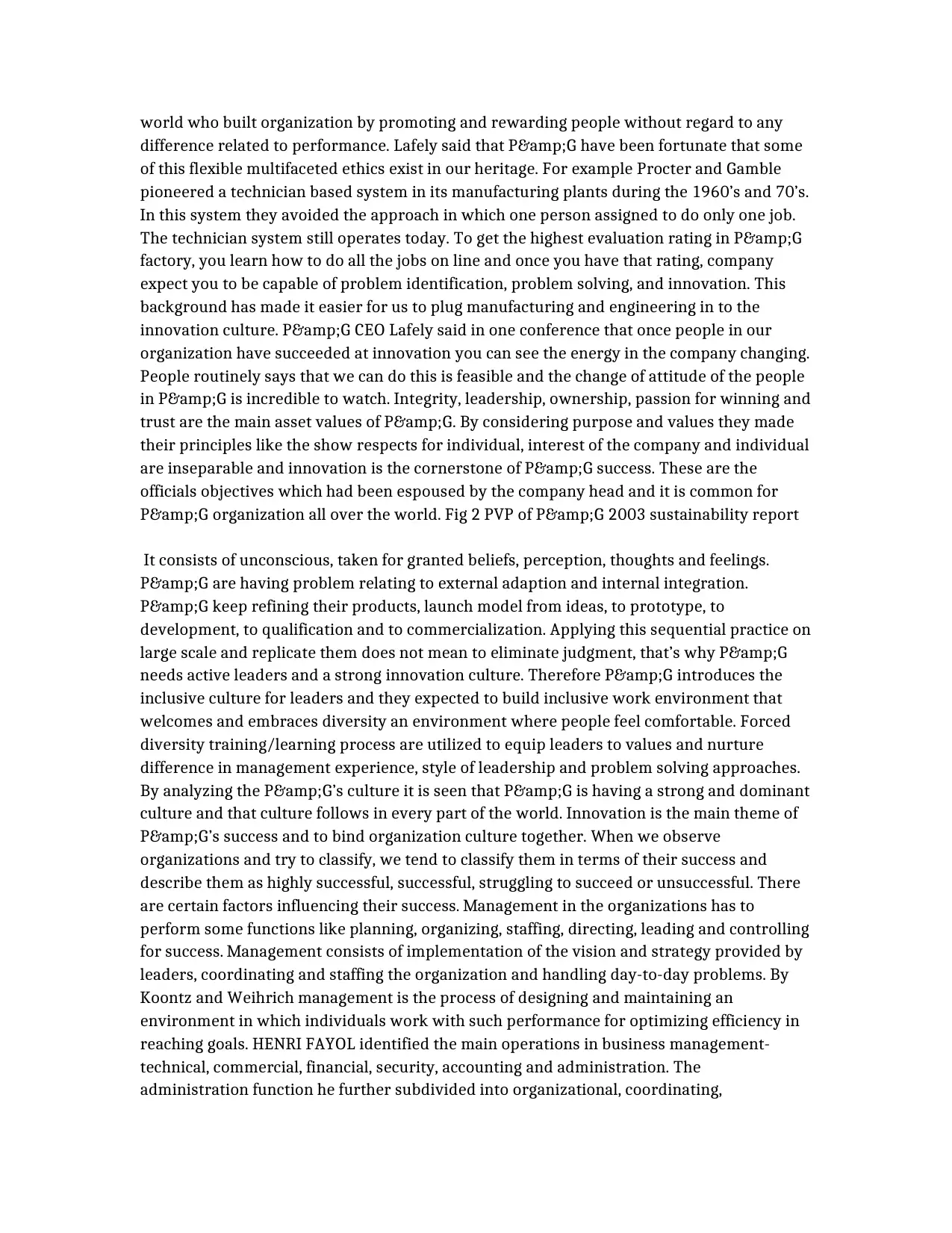
world who built organization by promoting and rewarding people without regard to any
difference related to performance. Lafely said that P&G have been fortunate that some
of this flexible multifaceted ethics exist in our heritage. For example Procter and Gamble
pioneered a technician based system in its manufacturing plants during the 1960’s and 70’s.
In this system they avoided the approach in which one person assigned to do only one job.
The technician system still operates today. To get the highest evaluation rating in P&G
factory, you learn how to do all the jobs on line and once you have that rating, company
expect you to be capable of problem identification, problem solving, and innovation. This
background has made it easier for us to plug manufacturing and engineering in to the
innovation culture. P&G CEO Lafely said in one conference that once people in our
organization have succeeded at innovation you can see the energy in the company changing.
People routinely says that we can do this is feasible and the change of attitude of the people
in P&G is incredible to watch. Integrity, leadership, ownership, passion for winning and
trust are the main asset values of P&G. By considering purpose and values they made
their principles like the show respects for individual, interest of the company and individual
are inseparable and innovation is the cornerstone of P&G success. These are the
officials objectives which had been espoused by the company head and it is common for
P&G organization all over the world. Fig 2 PVP of P&G 2003 sustainability report
It consists of unconscious, taken for granted beliefs, perception, thoughts and feelings.
P&G are having problem relating to external adaption and internal integration.
P&G keep refining their products, launch model from ideas, to prototype, to
development, to qualification and to commercialization. Applying this sequential practice on
large scale and replicate them does not mean to eliminate judgment, that’s why P&G
needs active leaders and a strong innovation culture. Therefore P&G introduces the
inclusive culture for leaders and they expected to build inclusive work environment that
welcomes and embraces diversity an environment where people feel comfortable. Forced
diversity training/learning process are utilized to equip leaders to values and nurture
difference in management experience, style of leadership and problem solving approaches.
By analyzing the P&G’s culture it is seen that P&G is having a strong and dominant
culture and that culture follows in every part of the world. Innovation is the main theme of
P&G’s success and to bind organization culture together. When we observe
organizations and try to classify, we tend to classify them in terms of their success and
describe them as highly successful, successful, struggling to succeed or unsuccessful. There
are certain factors influencing their success. Management in the organizations has to
perform some functions like planning, organizing, staffing, directing, leading and controlling
for success. Management consists of implementation of the vision and strategy provided by
leaders, coordinating and staffing the organization and handling day-to-day problems. By
Koontz and Weihrich management is the process of designing and maintaining an
environment in which individuals work with such performance for optimizing efficiency in
reaching goals. HENRI FAYOL identified the main operations in business management-
technical, commercial, financial, security, accounting and administration. The
administration function he further subdivided into organizational, coordinating,
difference related to performance. Lafely said that P&G have been fortunate that some
of this flexible multifaceted ethics exist in our heritage. For example Procter and Gamble
pioneered a technician based system in its manufacturing plants during the 1960’s and 70’s.
In this system they avoided the approach in which one person assigned to do only one job.
The technician system still operates today. To get the highest evaluation rating in P&G
factory, you learn how to do all the jobs on line and once you have that rating, company
expect you to be capable of problem identification, problem solving, and innovation. This
background has made it easier for us to plug manufacturing and engineering in to the
innovation culture. P&G CEO Lafely said in one conference that once people in our
organization have succeeded at innovation you can see the energy in the company changing.
People routinely says that we can do this is feasible and the change of attitude of the people
in P&G is incredible to watch. Integrity, leadership, ownership, passion for winning and
trust are the main asset values of P&G. By considering purpose and values they made
their principles like the show respects for individual, interest of the company and individual
are inseparable and innovation is the cornerstone of P&G success. These are the
officials objectives which had been espoused by the company head and it is common for
P&G organization all over the world. Fig 2 PVP of P&G 2003 sustainability report
It consists of unconscious, taken for granted beliefs, perception, thoughts and feelings.
P&G are having problem relating to external adaption and internal integration.
P&G keep refining their products, launch model from ideas, to prototype, to
development, to qualification and to commercialization. Applying this sequential practice on
large scale and replicate them does not mean to eliminate judgment, that’s why P&G
needs active leaders and a strong innovation culture. Therefore P&G introduces the
inclusive culture for leaders and they expected to build inclusive work environment that
welcomes and embraces diversity an environment where people feel comfortable. Forced
diversity training/learning process are utilized to equip leaders to values and nurture
difference in management experience, style of leadership and problem solving approaches.
By analyzing the P&G’s culture it is seen that P&G is having a strong and dominant
culture and that culture follows in every part of the world. Innovation is the main theme of
P&G’s success and to bind organization culture together. When we observe
organizations and try to classify, we tend to classify them in terms of their success and
describe them as highly successful, successful, struggling to succeed or unsuccessful. There
are certain factors influencing their success. Management in the organizations has to
perform some functions like planning, organizing, staffing, directing, leading and controlling
for success. Management consists of implementation of the vision and strategy provided by
leaders, coordinating and staffing the organization and handling day-to-day problems. By
Koontz and Weihrich management is the process of designing and maintaining an
environment in which individuals work with such performance for optimizing efficiency in
reaching goals. HENRI FAYOL identified the main operations in business management-
technical, commercial, financial, security, accounting and administration. The
administration function he further subdivided into organizational, coordinating,
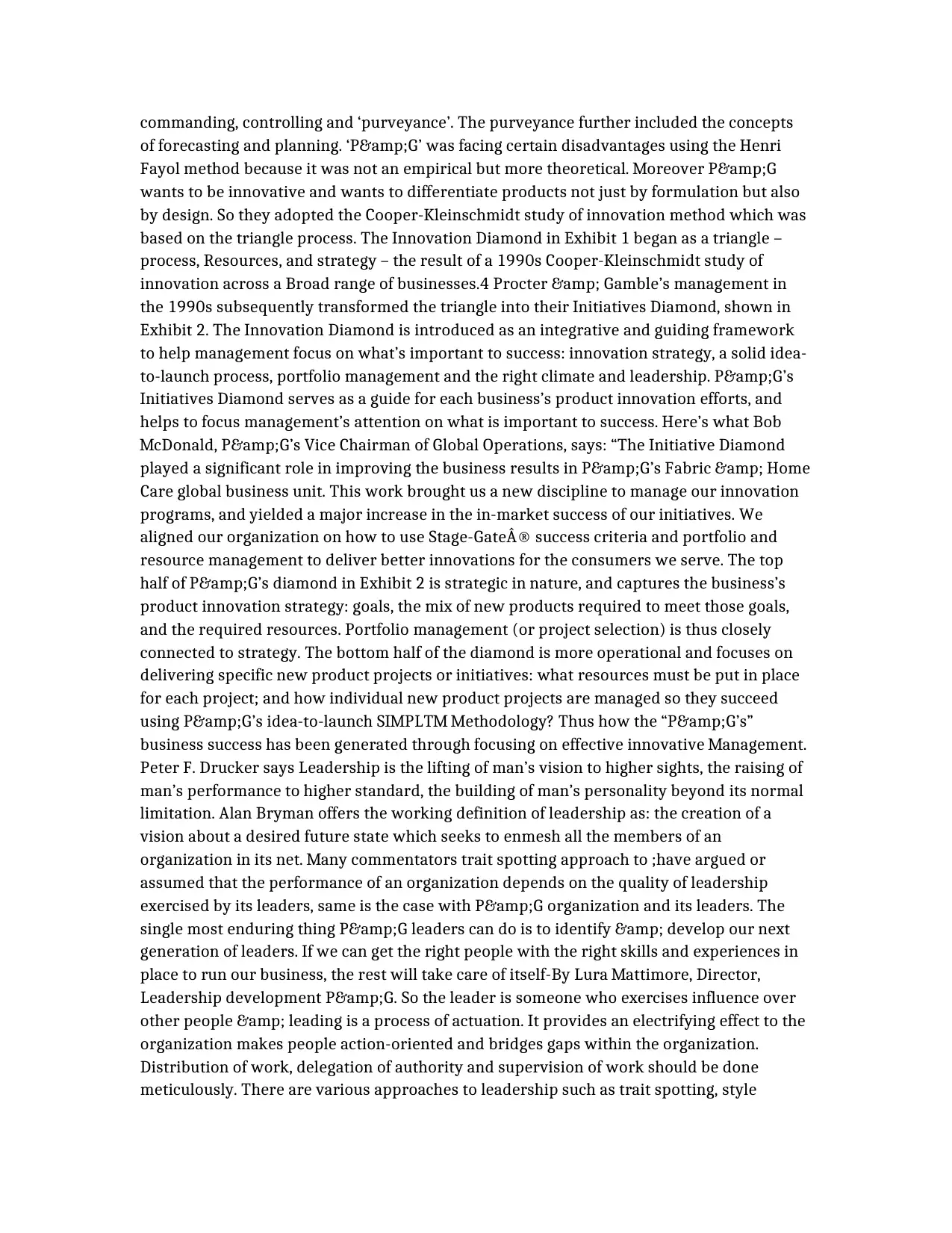
commanding, controlling and ‘purveyance’. The purveyance further included the concepts
of forecasting and planning. ‘P&G’ was facing certain disadvantages using the Henri
Fayol method because it was not an empirical but more theoretical. Moreover P&G
wants to be innovative and wants to differentiate products not just by formulation but also
by design. So they adopted the Cooper-Kleinschmidt study of innovation method which was
based on the triangle process. The Innovation Diamond in Exhibit 1 began as a triangle –
process, Resources, and strategy – the result of a 1990s Cooper-Kleinschmidt study of
innovation across a Broad range of businesses.4 Procter & Gamble’s management in
the 1990s subsequently transformed the triangle into their Initiatives Diamond, shown in
Exhibit 2. The Innovation Diamond is introduced as an integrative and guiding framework
to help management focus on what’s important to success: innovation strategy, a solid idea-
to-launch process, portfolio management and the right climate and leadership. P&G’s
Initiatives Diamond serves as a guide for each business’s product innovation efforts, and
helps to focus management’s attention on what is important to success. Here’s what Bob
McDonald, P&G’s Vice Chairman of Global Operations, says: “The Initiative Diamond
played a significant role in improving the business results in P&G’s Fabric & Home
Care global business unit. This work brought us a new discipline to manage our innovation
programs, and yielded a major increase in the in-market success of our initiatives. We
aligned our organization on how to use Stage-Gate® success criteria and portfolio and
resource management to deliver better innovations for the consumers we serve. The top
half of P&G’s diamond in Exhibit 2 is strategic in nature, and captures the business’s
product innovation strategy: goals, the mix of new products required to meet those goals,
and the required resources. Portfolio management (or project selection) is thus closely
connected to strategy. The bottom half of the diamond is more operational and focuses on
delivering specific new product projects or initiatives: what resources must be put in place
for each project; and how individual new product projects are managed so they succeed
using P&G’s idea-to-launch SIMPLTM Methodology? Thus how the “P&G’s”
business success has been generated through focusing on effective innovative Management.
Peter F. Drucker says Leadership is the lifting of man’s vision to higher sights, the raising of
man’s performance to higher standard, the building of man’s personality beyond its normal
limitation. Alan Bryman offers the working definition of leadership as: the creation of a
vision about a desired future state which seeks to enmesh all the members of an
organization in its net. Many commentators trait spotting approach to ;have argued or
assumed that the performance of an organization depends on the quality of leadership
exercised by its leaders, same is the case with P&G organization and its leaders. The
single most enduring thing P&G leaders can do is to identify & develop our next
generation of leaders. If we can get the right people with the right skills and experiences in
place to run our business, the rest will take care of itself-By Lura Mattimore, Director,
Leadership development P&G. So the leader is someone who exercises influence over
other people & leading is a process of actuation. It provides an electrifying effect to the
organization makes people action-oriented and bridges gaps within the organization.
Distribution of work, delegation of authority and supervision of work should be done
meticulously. There are various approaches to leadership such as trait spotting, style
of forecasting and planning. ‘P&G’ was facing certain disadvantages using the Henri
Fayol method because it was not an empirical but more theoretical. Moreover P&G
wants to be innovative and wants to differentiate products not just by formulation but also
by design. So they adopted the Cooper-Kleinschmidt study of innovation method which was
based on the triangle process. The Innovation Diamond in Exhibit 1 began as a triangle –
process, Resources, and strategy – the result of a 1990s Cooper-Kleinschmidt study of
innovation across a Broad range of businesses.4 Procter & Gamble’s management in
the 1990s subsequently transformed the triangle into their Initiatives Diamond, shown in
Exhibit 2. The Innovation Diamond is introduced as an integrative and guiding framework
to help management focus on what’s important to success: innovation strategy, a solid idea-
to-launch process, portfolio management and the right climate and leadership. P&G’s
Initiatives Diamond serves as a guide for each business’s product innovation efforts, and
helps to focus management’s attention on what is important to success. Here’s what Bob
McDonald, P&G’s Vice Chairman of Global Operations, says: “The Initiative Diamond
played a significant role in improving the business results in P&G’s Fabric & Home
Care global business unit. This work brought us a new discipline to manage our innovation
programs, and yielded a major increase in the in-market success of our initiatives. We
aligned our organization on how to use Stage-Gate® success criteria and portfolio and
resource management to deliver better innovations for the consumers we serve. The top
half of P&G’s diamond in Exhibit 2 is strategic in nature, and captures the business’s
product innovation strategy: goals, the mix of new products required to meet those goals,
and the required resources. Portfolio management (or project selection) is thus closely
connected to strategy. The bottom half of the diamond is more operational and focuses on
delivering specific new product projects or initiatives: what resources must be put in place
for each project; and how individual new product projects are managed so they succeed
using P&G’s idea-to-launch SIMPLTM Methodology? Thus how the “P&G’s”
business success has been generated through focusing on effective innovative Management.
Peter F. Drucker says Leadership is the lifting of man’s vision to higher sights, the raising of
man’s performance to higher standard, the building of man’s personality beyond its normal
limitation. Alan Bryman offers the working definition of leadership as: the creation of a
vision about a desired future state which seeks to enmesh all the members of an
organization in its net. Many commentators trait spotting approach to ;have argued or
assumed that the performance of an organization depends on the quality of leadership
exercised by its leaders, same is the case with P&G organization and its leaders. The
single most enduring thing P&G leaders can do is to identify & develop our next
generation of leaders. If we can get the right people with the right skills and experiences in
place to run our business, the rest will take care of itself-By Lura Mattimore, Director,
Leadership development P&G. So the leader is someone who exercises influence over
other people & leading is a process of actuation. It provides an electrifying effect to the
organization makes people action-oriented and bridges gaps within the organization.
Distribution of work, delegation of authority and supervision of work should be done
meticulously. There are various approaches to leadership such as trait spotting, style
⊘ This is a preview!⊘
Do you want full access?
Subscribe today to unlock all pages.

Trusted by 1+ million students worldwide
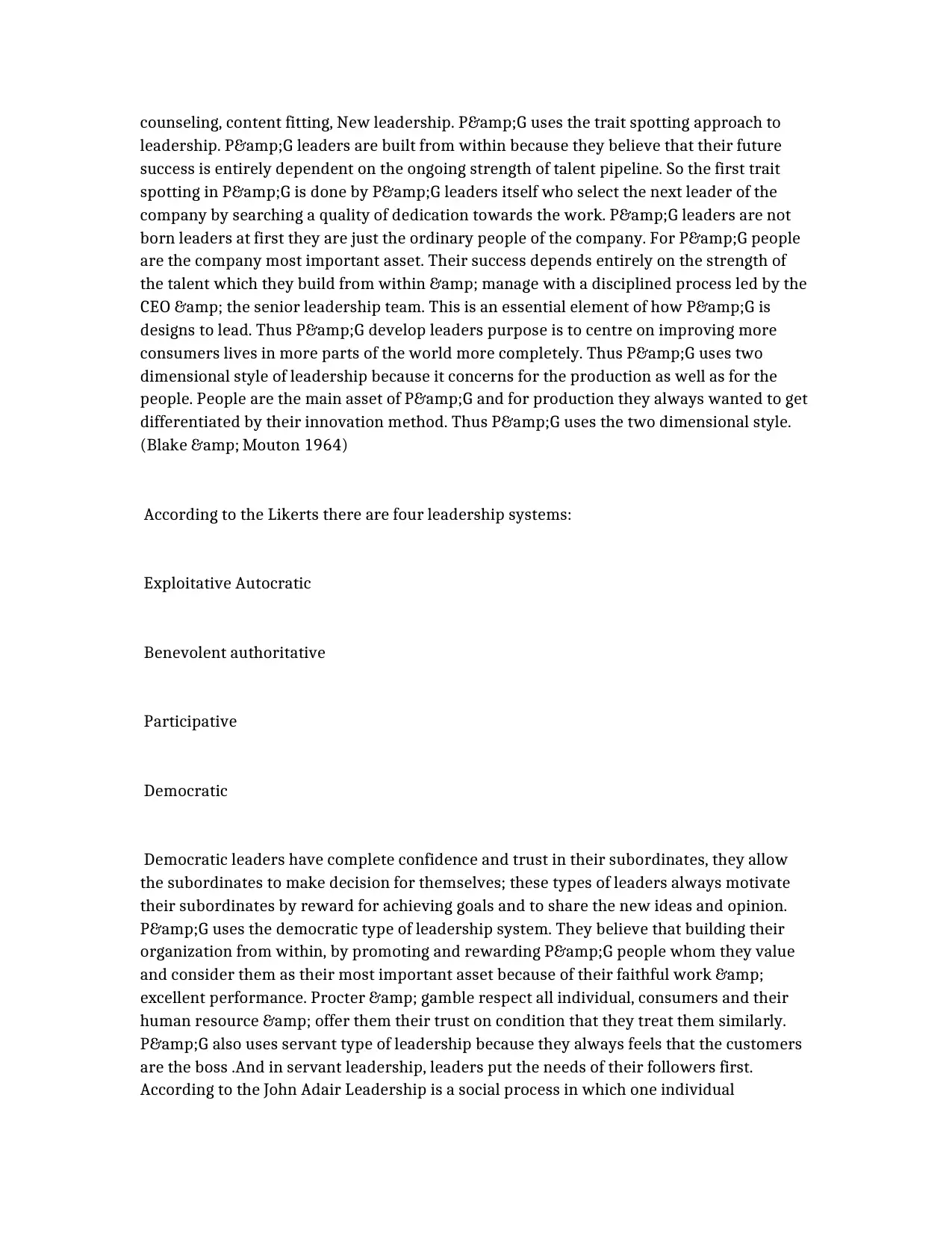
counseling, content fitting, New leadership. P&G uses the trait spotting approach to
leadership. P&G leaders are built from within because they believe that their future
success is entirely dependent on the ongoing strength of talent pipeline. So the first trait
spotting in P&G is done by P&G leaders itself who select the next leader of the
company by searching a quality of dedication towards the work. P&G leaders are not
born leaders at first they are just the ordinary people of the company. For P&G people
are the company most important asset. Their success depends entirely on the strength of
the talent which they build from within & manage with a disciplined process led by the
CEO & the senior leadership team. This is an essential element of how P&G is
designs to lead. Thus P&G develop leaders purpose is to centre on improving more
consumers lives in more parts of the world more completely. Thus P&G uses two
dimensional style of leadership because it concerns for the production as well as for the
people. People are the main asset of P&G and for production they always wanted to get
differentiated by their innovation method. Thus P&G uses the two dimensional style.
(Blake & Mouton 1964)
According to the Likerts there are four leadership systems:
Exploitative Autocratic
Benevolent authoritative
Participative
Democratic
Democratic leaders have complete confidence and trust in their subordinates, they allow
the subordinates to make decision for themselves; these types of leaders always motivate
their subordinates by reward for achieving goals and to share the new ideas and opinion.
P&G uses the democratic type of leadership system. They believe that building their
organization from within, by promoting and rewarding P&G people whom they value
and consider them as their most important asset because of their faithful work &
excellent performance. Procter & gamble respect all individual, consumers and their
human resource & offer them their trust on condition that they treat them similarly.
P&G also uses servant type of leadership because they always feels that the customers
are the boss .And in servant leadership, leaders put the needs of their followers first.
According to the John Adair Leadership is a social process in which one individual
leadership. P&G leaders are built from within because they believe that their future
success is entirely dependent on the ongoing strength of talent pipeline. So the first trait
spotting in P&G is done by P&G leaders itself who select the next leader of the
company by searching a quality of dedication towards the work. P&G leaders are not
born leaders at first they are just the ordinary people of the company. For P&G people
are the company most important asset. Their success depends entirely on the strength of
the talent which they build from within & manage with a disciplined process led by the
CEO & the senior leadership team. This is an essential element of how P&G is
designs to lead. Thus P&G develop leaders purpose is to centre on improving more
consumers lives in more parts of the world more completely. Thus P&G uses two
dimensional style of leadership because it concerns for the production as well as for the
people. People are the main asset of P&G and for production they always wanted to get
differentiated by their innovation method. Thus P&G uses the two dimensional style.
(Blake & Mouton 1964)
According to the Likerts there are four leadership systems:
Exploitative Autocratic
Benevolent authoritative
Participative
Democratic
Democratic leaders have complete confidence and trust in their subordinates, they allow
the subordinates to make decision for themselves; these types of leaders always motivate
their subordinates by reward for achieving goals and to share the new ideas and opinion.
P&G uses the democratic type of leadership system. They believe that building their
organization from within, by promoting and rewarding P&G people whom they value
and consider them as their most important asset because of their faithful work &
excellent performance. Procter & gamble respect all individual, consumers and their
human resource & offer them their trust on condition that they treat them similarly.
P&G also uses servant type of leadership because they always feels that the customers
are the boss .And in servant leadership, leaders put the needs of their followers first.
According to the John Adair Leadership is a social process in which one individual
Paraphrase This Document
Need a fresh take? Get an instant paraphrase of this document with our AI Paraphraser
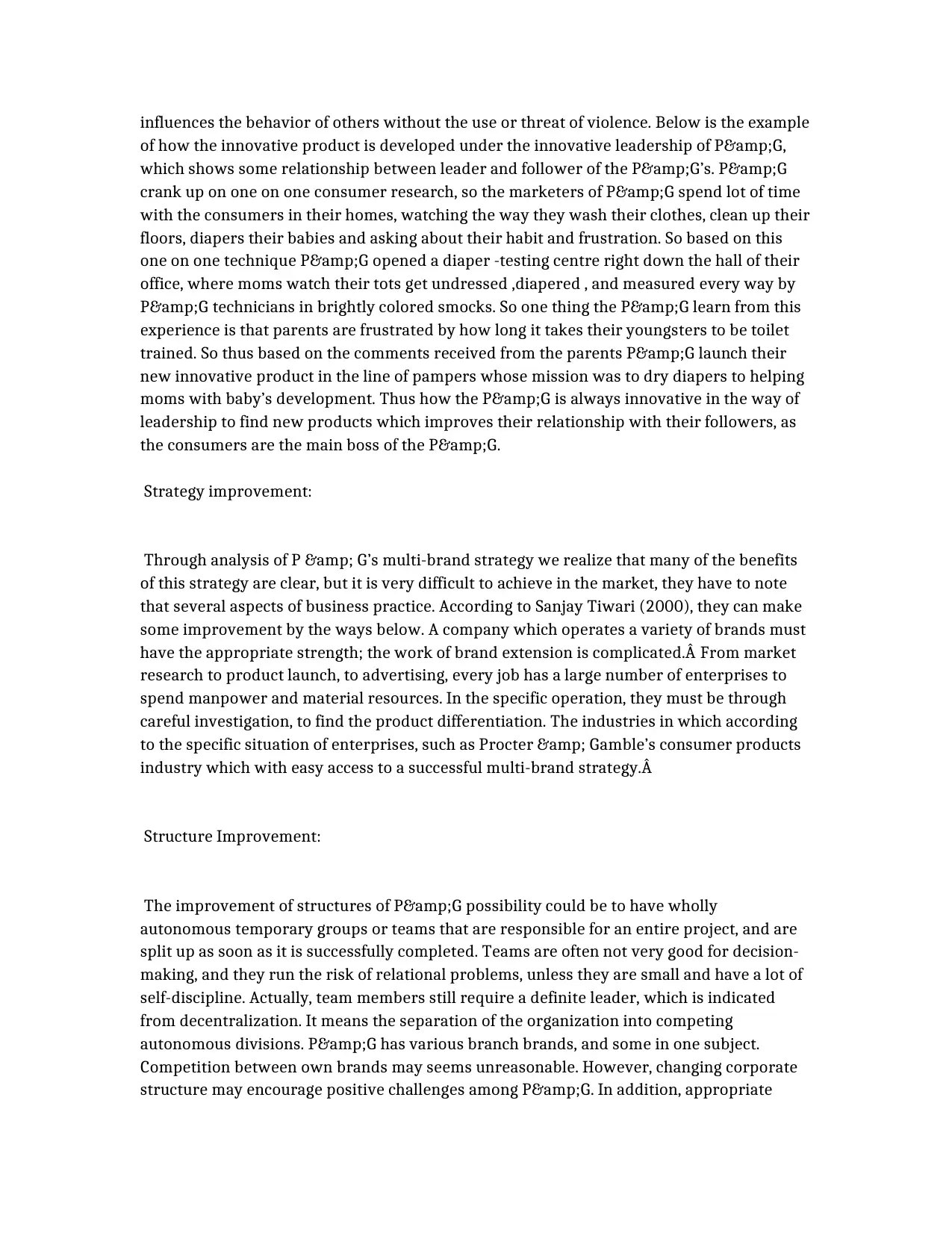
influences the behavior of others without the use or threat of violence. Below is the example
of how the innovative product is developed under the innovative leadership of P&G,
which shows some relationship between leader and follower of the P&G’s. P&G
crank up on one on one consumer research, so the marketers of P&G spend lot of time
with the consumers in their homes, watching the way they wash their clothes, clean up their
floors, diapers their babies and asking about their habit and frustration. So based on this
one on one technique P&G opened a diaper -testing centre right down the hall of their
office, where moms watch their tots get undressed ,diapered , and measured every way by
P&G technicians in brightly colored smocks. So one thing the P&G learn from this
experience is that parents are frustrated by how long it takes their youngsters to be toilet
trained. So thus based on the comments received from the parents P&G launch their
new innovative product in the line of pampers whose mission was to dry diapers to helping
moms with baby’s development. Thus how the P&G is always innovative in the way of
leadership to find new products which improves their relationship with their followers, as
the consumers are the main boss of the P&G.
Strategy improvement:
Through analysis of P & G’s multi-brand strategy we realize that many of the benefits
of this strategy are clear, but it is very difficult to achieve in the market, they have to note
that several aspects of business practice. According to Sanjay Tiwari (2000), they can make
some improvement by the ways below. A company which operates a variety of brands must
have the appropriate strength; the work of brand extension is complicated. From market
research to product launch, to advertising, every job has a large number of enterprises to
spend manpower and material resources. In the specific operation, they must be through
careful investigation, to find the product differentiation. The industries in which according
to the specific situation of enterprises, such as Procter & Gamble’s consumer products
industry which with easy access to a successful multi-brand strategy.Â
Structure Improvement:
The improvement of structures of P&G possibility could be to have wholly
autonomous temporary groups or teams that are responsible for an entire project, and are
split up as soon as it is successfully completed. Teams are often not very good for decision-
making, and they run the risk of relational problems, unless they are small and have a lot of
self-discipline. Actually, team members still require a definite leader, which is indicated
from decentralization. It means the separation of the organization into competing
autonomous divisions. P&G has various branch brands, and some in one subject.
Competition between own brands may seems unreasonable. However, changing corporate
structure may encourage positive challenges among P&G. In addition, appropriate
of how the innovative product is developed under the innovative leadership of P&G,
which shows some relationship between leader and follower of the P&G’s. P&G
crank up on one on one consumer research, so the marketers of P&G spend lot of time
with the consumers in their homes, watching the way they wash their clothes, clean up their
floors, diapers their babies and asking about their habit and frustration. So based on this
one on one technique P&G opened a diaper -testing centre right down the hall of their
office, where moms watch their tots get undressed ,diapered , and measured every way by
P&G technicians in brightly colored smocks. So one thing the P&G learn from this
experience is that parents are frustrated by how long it takes their youngsters to be toilet
trained. So thus based on the comments received from the parents P&G launch their
new innovative product in the line of pampers whose mission was to dry diapers to helping
moms with baby’s development. Thus how the P&G is always innovative in the way of
leadership to find new products which improves their relationship with their followers, as
the consumers are the main boss of the P&G.
Strategy improvement:
Through analysis of P & G’s multi-brand strategy we realize that many of the benefits
of this strategy are clear, but it is very difficult to achieve in the market, they have to note
that several aspects of business practice. According to Sanjay Tiwari (2000), they can make
some improvement by the ways below. A company which operates a variety of brands must
have the appropriate strength; the work of brand extension is complicated. From market
research to product launch, to advertising, every job has a large number of enterprises to
spend manpower and material resources. In the specific operation, they must be through
careful investigation, to find the product differentiation. The industries in which according
to the specific situation of enterprises, such as Procter & Gamble’s consumer products
industry which with easy access to a successful multi-brand strategy.Â
Structure Improvement:
The improvement of structures of P&G possibility could be to have wholly
autonomous temporary groups or teams that are responsible for an entire project, and are
split up as soon as it is successfully completed. Teams are often not very good for decision-
making, and they run the risk of relational problems, unless they are small and have a lot of
self-discipline. Actually, team members still require a definite leader, which is indicated
from decentralization. It means the separation of the organization into competing
autonomous divisions. P&G has various branch brands, and some in one subject.
Competition between own brands may seems unreasonable. However, changing corporate
structure may encourage positive challenges among P&G. In addition, appropriate
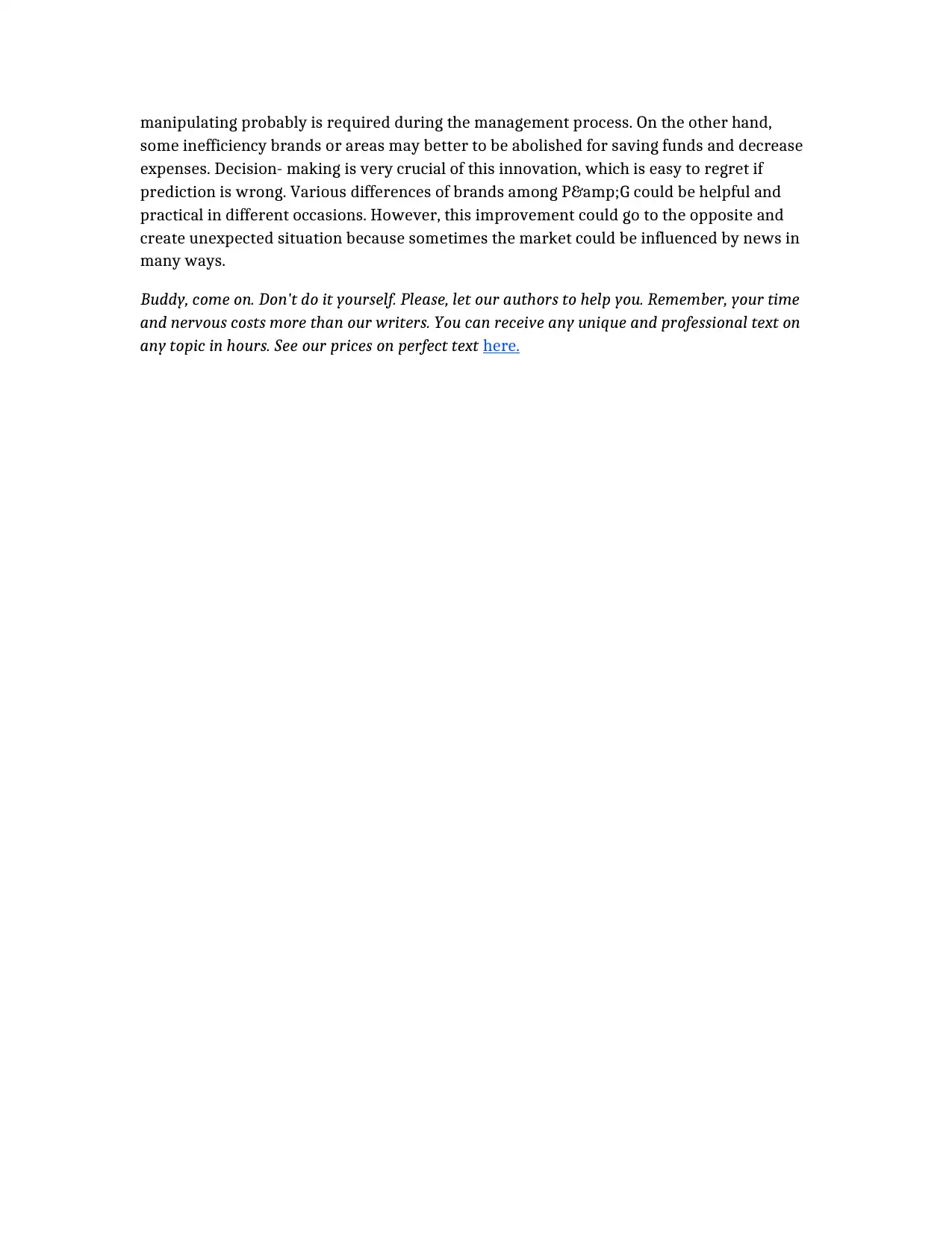
manipulating probably is required during the management process. On the other hand,
some inefficiency brands or areas may better to be abolished for saving funds and decrease
expenses. Decision- making is very crucial of this innovation, which is easy to regret if
prediction is wrong. Various differences of brands among P&G could be helpful and
practical in different occasions. However, this improvement could go to the opposite and
create unexpected situation because sometimes the market could be influenced by news in
many ways.
Buddy, come on. Don't do it yourself. Please, let our authors to help you. Remember, your time
and nervous costs more than our writers. You can receive any unique and professional text on
any topic in hours. See our prices on perfect text here.
some inefficiency brands or areas may better to be abolished for saving funds and decrease
expenses. Decision- making is very crucial of this innovation, which is easy to regret if
prediction is wrong. Various differences of brands among P&G could be helpful and
practical in different occasions. However, this improvement could go to the opposite and
create unexpected situation because sometimes the market could be influenced by news in
many ways.
Buddy, come on. Don't do it yourself. Please, let our authors to help you. Remember, your time
and nervous costs more than our writers. You can receive any unique and professional text on
any topic in hours. See our prices on perfect text here.
⊘ This is a preview!⊘
Do you want full access?
Subscribe today to unlock all pages.

Trusted by 1+ million students worldwide
1 out of 12
Related Documents
Your All-in-One AI-Powered Toolkit for Academic Success.
+13062052269
info@desklib.com
Available 24*7 on WhatsApp / Email
![[object Object]](/_next/static/media/star-bottom.7253800d.svg)
Unlock your academic potential
Copyright © 2020–2025 A2Z Services. All Rights Reserved. Developed and managed by ZUCOL.



![Marketing Research Proposal: P&G, [University Name], [Semester]](/_next/image/?url=https%3A%2F%2Fdesklib.com%2Fmedia%2Fimages%2Fzf%2F00de572d867346098403ef6c09b168c9.jpg&w=256&q=75)
